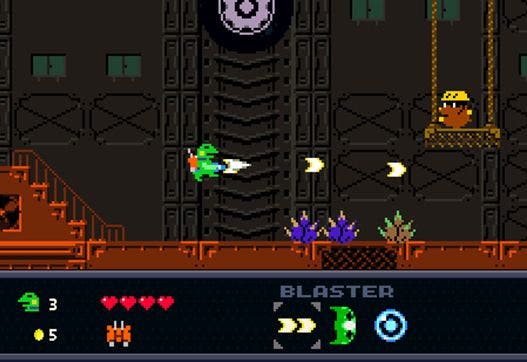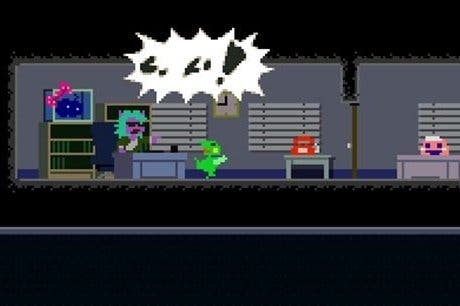Kero Blaster review
Blast from the past.
Daisuke Amaya's work provides a fierce rebuttal to the accusation that 'they don't make 'em like they used to'. While most indie game-makers are content to appropriate the style of 80s video games as a celebratory, nostalgic wrapping for contemporary ideas, Amaya's games have a deeper sort of period authenticity.
This was true of 2004's Cave Story (one of the first and most successful Japanese indie games), with its simple, bold interactions and alluring network of tunnels, and it's true of Kero Blaster, his latest creation, a trim platform game for PC and iOS. Beneath the chunky, flatly coloured pixels, Kero Blaster feels like a lost Atari VCS game, with economical but fluid controls, stout level design and a lazily cool chip-tune soundtrack.
You play as a yellow-cheeked bipedal frog with an adorable two-pixel overbite. Frog works in the inexact field of 'custodial sciences' for the Cat & Frog company. He appears to be the brawn of the operation. His job is to clean up the teleporters that lead from the company's building out into the surrounding countryside. These remote computers have become clogged with what appear to be dust mites, but which are later revealed to be 'Negativus Legatia', or forgotten bits of people's history that have spilled off internet servers into the world.

If this is mild commentary from Amaya on the digital flotsam that we leave of ourselves on social media networks, it's not something he's willing to explore at anything but the most surface level. Primarily, Kero Blaster is interested in the lost art of the platform game shoot-'em-up; players must guide the frog from pillar to post with careful leaps while taking down the weird array of cutesy, deadly wildlife that stands between him and the jacked-up PCs.
There's an artisanal whimsy to the art and design: the pause menu is wallpapered with huffing coffee mugs; late in the game, Frog is given a fur coat (which allows him to absorb an enemy hit without taking damage); some enemies wear hard hats or hide inside polar bear snowmen, popping out to take pot-shots. There are swooping purple parrots, angry bees, gloopy monsters that rise from the mud and, when you lose all of your lives, you wind up in Tonekawa Hospital, naked on a starched mattress, recuperating. But there's an ease to the eccentricity that stops the game from tipping into hipster affectation. These are the kind of designs that Amaya digs, and he's not trying to impress anybody with them - something that can't be said for all contemporary American indie games.

Regardless of whether you appreciate Kero Blaster's quirky VCS façade, the game's underlying feel is entirely impressive. It lives on its control system (best played with a console controller on PC), which is disarmingly straightforward yet always a joy. You have a jump button and a shoot button and, aside from the ability to switch between types of shot, that's all. Hold the fire button down and you continue to fire in that direction, even if you run the opposite way. This allows you to, for example, fire directly upwards to the underside of a boss who's standing on the platform above while you dodge his hail of attacks. It's an intuitive technique, lifted from arcade shoot-'em-ups, that allows for expressive play from the get-go.
As you defeat each stage's boss character you unlock new weapons: a Contra-esque wide (but short) beam, a hail of bubbles that trip off platforms onto enemy heads, a flame-thrower that burns up ice enemies and so on. Each shot type is distinct enough to be useful in certain circumstances. As with all of Amaya's designs, nothing is wasted and nothing is surplus to requirements. Different boss characters require different techniques and different techniques require different types of shot; it's a case of choosing the right tool for the job in each scenario and adapting to your environment.

Frog begins the game with two Zelda-esque hearts. Take a single hit from an enemy and you lose a heart. Lose a heart and you lose a life, returning to the most recent checkpoint. Lose all of your lives and you'll have to restart the entire stage. Late in each stage you come across a floating bubble emblazoned with the Cat and Frog Inc. logo. Jump into the bubble and you're transported to a rather staid-looking room that contains two hatches. At one you're able to use the coins that you've collected from downed enemies to buy upgrades to your weapons that, for example, turn your blast shots into laser beams, or increase the width of your wide shot. The other will replenish your health and, for an extortionate amount, sell you new lives. The more times you restart a stage, the more money you accrue, so less able players will be able to upgrade Frog across all of his offensive and defensive capabilities, while more skilled players must choose which element to prioritise.
The game's latter stages are longer and more demanding: platforms become thinner and require more precise timing with jetpack thrusts and leaps. But there are so few superfluous adornments that, even when you're sent back to the beginning of a stage, you'll rarely switch off. Kero Blaster's sharpness of focus elicits the same response in its player. While research shows that the majority of games remain unfinished by their players, Kero Blaster draws you steadily through to its conclusion, a three-hour trip that demands to be finished. Amaya's singular vision is beguiling and, while this game is a more straightforward proposition than the enchanting crisscross complexity of Cave Story, it's no less delightful.










